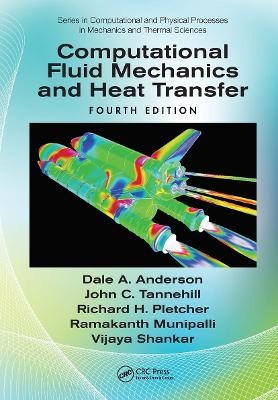
Computational Fluid Mechanics and Heat Transfer
Crc Press Inc (Verlag)
978-0-8153-5712-4 (ISBN)
Provides a thoroughly updated presentation of CFD and computational heat transfer
Covers more material than other texts, organized for classroom instruction and self-study
Presents a wide range of computation strategies for fluid flow and heat transfer
Includes new sections on finite element methods, computational heat transfer, and multiphase flows
Features a full Solutions Manual and Figure Slides for classroom projection
Written as an introductory text for advanced undergraduates and first-year graduate students, the new edition provides the background necessary for solving complex problems in fluid mechanics and heat transfer.
Dale A. Anderson received his M.S. and Ph.D. in Aerospace and Electrical Engineering from Iowa State University; he has served as the Dean of Graduate Studies, Vice President for Research and Associate Dean in the College of Engineering at the University of Texas at Arlington, and as Director of the Computational Fluid Dynamics Center at Iowa State University. Dr. Anderson has served as a consultant, and also in full-time positions with McDonnell-Douglas, the Boeing Company, Aerospace Corporation, the U.S. Air Force, FMC Corporation, British Petroleum, Union Carbide, Viskase Corporation, and Lockheed-Martin. John C. Tannehill received his Ph.D. degrees in Aerospace Engineering and Mechanical Engineering from Iowa State University, where he also served as a professor of Aerospace Engineering and Engineering Mechanics, and as Manager of the Computational Fluid Dynamics Center. Dr. Tannehill has held positions at the NASA Dyden Research Center, Aerospace Corporation, and NASA Ames Research Center, and has served as a technical consultant for several industrial firms. He is the author of numerous technical papers in the area of computational fluid dynamics, and he is a Fellow of the American Institute of Aeronautics and Astronautics. Richard H. Pletcher received his B.S. degree from Purdue University, and his M.S. and Ph.D. degrees from Cornell University. At Iowa State University he served as a Professor of Mechanical Engineering and Associate Manager of the Computational Fluid Dynamics Center. He was an associate editor of the Journal of Heat Transfer, and a member of the advisory board for Numerical Heat Transfer. Dr. Pletcher passed away in 2015. Ramakanth Munipalli received his B.Tech from IIT Madras (India), MS and Ph.D. from the University of Texas at Arlington, all in Aerospace Engineering. He is currently a Senior Aerospace Research Engineer at the U.S. Air Force Research Laboratory (Edwards AFB). Previously, he was a Senior Computational Physicist at HyPerComp Inc. in Westlake Village, California. At AFRL, his work is mainly in the application of model reduction and data science techniques to high fidelity CFD in aerospace propulsion. At HyPerComp Inc., he has worked on computational magnetohydrodynamics, simulations of turbulent combustion, and high order accurate solver development. His research was supported by DoE, DoD, and various private companies, and has included extensive collaboration with experts from the academia. Vijaya Shankar received his M.S. degree and Ph.D. degree (in 1977) both in Aerospace Engineering, from Iowa State University. He joined the Rockwell International Science Center in 1976. At Rockwell, he was responsible for developing multidisciplinary computing technologies involving fluid dynamics, electromagnetics, structures and other related disciplines that are critical for both defense and commercial programs. Dr. Shankar formed HyPerComp, Inc. in 1998 to advance the state of the art in time-domain computational electromagnetic (CEM) using high performance computing parallel architectures for DoD and other customers.
Part I: Fundamentals. 1. Introduction. 2. Partial Differential Equations. 3. Basics of Discretization Methods. 4. Application of Numerical Methods to Selected Model Equations. Part II: Application of Numerical Methods to the Equations of Fluid Mechanics and Heat Transfer. 5. Governing Equations of Fluid Mechanics and Heat Transfer. 6. Numerical Methods for Inviscid Flow Equations. 7. Numerical Methods for Boundary-Layer-Type Equations. 8. Numerical Methods for the "Parabolized" Navier–Stokes Equations. 9. Numerical Methods for the Navier–Stokes Equations. 10. Grid Generation.
| Erscheinungsdatum | 16.01.2021 |
|---|---|
| Reihe/Serie | Computational and Physical Processes in Mechanics and Thermal Sciences |
| Zusatzinfo | 27 Tables, black and white; 58 Illustrations, color; 273 Illustrations, black and white |
| Verlagsort | Bosa Roca |
| Sprache | englisch |
| Maße | 178 x 254 mm |
| Gewicht | 1560 g |
| Themenwelt | Mathematik / Informatik ► Mathematik ► Angewandte Mathematik |
| Naturwissenschaften ► Physik / Astronomie ► Strömungsmechanik | |
| Technik ► Maschinenbau | |
| Technik ► Umwelttechnik / Biotechnologie | |
| ISBN-10 | 0-8153-5712-5 / 0815357125 |
| ISBN-13 | 978-0-8153-5712-4 / 9780815357124 |
| Zustand | Neuware |
| Informationen gemäß Produktsicherheitsverordnung (GPSR) | |
| Haben Sie eine Frage zum Produkt? |
aus dem Bereich


